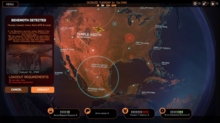
XCOM, is a science fiction video game franchise featuring an elite international organization tasked with countering alien invasions of Earth. The series began with the strategy video game X-COM: UFO Defense created by Julian Gollop's Mythos Games and MicroProse in 1994. The original lineup by MicroProse included six published and at least two canceled games, as well as two novels. The X-COM series, in particular its original entry, achieved a sizable cult following and has influenced many other video games; including the creation of a number of clones, spiritual successors, and unofficial remakes.

X-COM: Apocalypse is a 1997 science fiction tactical strategy game. It is the third game in the X-COM video game series. It was developed by Mythos Games, and published by MicroProse in 1997 for DOS and Microsoft Windows.
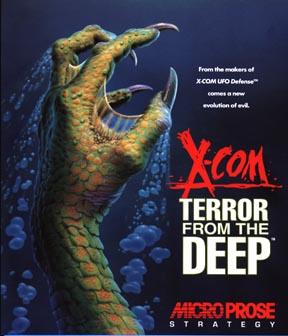
X-COM: Terror from the Deep is a strategy video game developed and published by MicroProse for the PC in 1995 and for the PlayStation in 1996. It is a sequel to X-COM: UFO Defense and the second game of the X-COM series, this time taking the war against a renewed alien invasion into the Earth's oceans.

UFO: Enemy Unknown, also known as X-COM: UFO Defense in North America, is a 1994 science fiction strategy video game developed by Mythos Games and MicroProse. It was published by MicroProse for DOS and Amiga computers, the Amiga CD32 console, and the PlayStation. Originally planned by Julian Gollop as a sequel to Mythos Games' 1988 Laser Squad, the game mixes real-time management simulation with turn-based tactics. The player takes the role of commander of X-COM – an international paramilitary and scientific organization secretly defending Earth from an alien invasion. Through the game, the player is tasked with issuing orders to individual X-COM troops in a series of turn-based tactical missions. At strategic scale, the player directs the research and development of new technologies, builds and expands X-COM's bases, manages the organization's finances and personnel, and monitors and responds to UFO activity.

Jonas Kyratzes is a German-Greek video game designer and author of video game industry related articles.
Tactical role-playing games, also known as strategy role-playing games and in Japan as simulation RPGs, are a video game genre that combines core elements of role-playing video games with those of tactical strategy video games. The formats of tactical RPGs are much like traditional tabletop role-playing games and strategy games in appearance, pacing, and rule structure. Likewise, early tabletop role-playing games are descended from skirmish wargames such as Chainmail, which were primarily concerned with combat.

X-COM: Alliance is a cancelled video game in the X-COM series. The game was developed by two different teams of MicroProse developers between 1995 and 2002. It had the player assume the role of commander of the militarized scientific mission lost in space during the aftermath of X-COM: Terror from the Deep.
Julian Gollop is a British video game designer and producer specialising in strategy games, who has founded and led Mythos Games, Codo Technologies and Snapshot Games. He is known best as the "man who gave birth to the X-COM franchise."
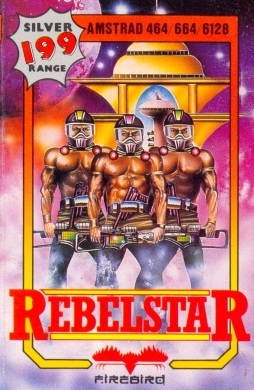
The Rebelstar games are a series of turn-based tactics video games designed by Julian Gollop. Rebelstar Raiders was published in 1984 by Red Shift for the ZX Spectrum. It was reworked in machine code as Rebelstar, published by Firebird in 1986. A sequel, Rebelstar II, was published in 1988 by Silverbird. Rebelstar, but not its sequel, was also adapted for the Amstrad CPC home computer.
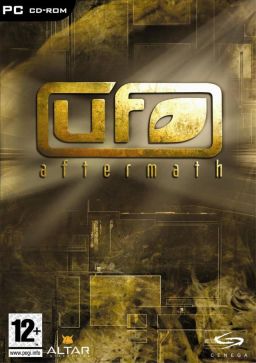
UFO: Aftermath is a 2003 real-time tactics/turn-based strategy video game created by ALTAR Interactive. It is a homage to the X-COM game series, with roots in the unfinished game The Dreamland Chronicles: Freedom Ridge. It was followed by two sequels, UFO: Aftershock (2005) and UFO: Afterlight (2007).

Rebelstar: Tactical Command is a turn-based tactics video game developed by Codo Technologies and published by Namco and Atari Europe for the Game Boy Advance in 2005. It's the fourth game in the Rebelstar series. The game was created by Julian Gollop, who previously designed X-COM: UFO Defense, Laser Squad and the original Rebelstar games.

The Bureau: XCOM Declassified is a 2013 tactical third-person shooter video game. It was developed by 2K Marin and published by 2K. As the eighth title in the turn-based strategy series X-COM and a narrative prequel to XCOM: Enemy Unknown, the game was released for PlayStation 3, Windows, and Xbox 360 in August 2013. Set in late 1962 at the height of the Cold War, the game's premise mainly revolves around The Bureau, the predecessor of the Extraterrestrial Combat Unit (XCOM), as they attempt to repel an alien invasion. As a tactical shooter, players can use the battle focus mode to issue commands to two other agents accompanying the protagonist, William Carter. Players can permanently lose their squad members so they must make good tactical decisions.
UFO: Alien Invasion is a strategy video game in which the player fights aliens that are trying to take control of the Earth. The game is heavily influenced by the X-COM series, especially X-COM: UFO Defense.

The Dreamland Chronicles: Freedom Ridge is an unreleased video game for Microsoft Windows and PlayStation 2 by Mythos Games. Developed by the team which produced X-COM: UFO Defense, including lead designer Julian Gollop, the game was planned to be "a remake of the first X-COM with 3D graphics," as the first of four games planned in the new series. Cancelled in 2001, the unfinished game was later bought and partially turned into UFO: Aftermath by Altar Interactive, which was in turn itself followed by two sequels. Some elements of the game are also present in Gollop's own Phoenix Point.

XCOM: Enemy Unknown is a 2012 turn-based tactics video game that was developed by Firaxis Games and published by 2K. It presents a "reimagined" version of the 1994 strategy game X-COM: UFO Defense—also known as UFO: Enemy Unknown. XCOM: Enemy Unknown is set during an alien invasion of Earth in an alternative version of 2015; the player controls an elite, multinational, paramilitary organization called XCOM and commands troops in a series of turn-based tactical missions. Between missions, the player directs the research and development of technologies from recovered alien technology and captured prisoners, expands XCOM's base of operations, manages finances, and monitors and responds to alien activity.

XCOM: Enemy Within is an expansion pack for the turn-based tactical video game XCOM: Enemy Unknown. The expansion pack primarily adds new gameplay elements to the base game, as well as introducing new themes of transhumanism via aggressive gene therapy.
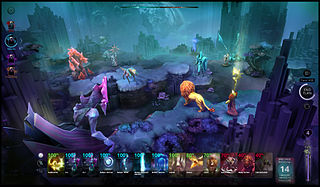
Chaos Reborn is a turn-based tactical role-playing game developed by Snapshot Games and was part funded through a Kickstarter crowdfunding campaign in April 2014. Following an early access release in December 2014, the full game was released in October 2015.

Fig was a crowdfunding platform for video games. It launched in August 2015. Unlike traditional crowdfunding approaches like Kickstarter, where individuals can back a project to receive rewards, Fig used a mixed model that includes individual backing and the opportunity for uncredited investors to invest as to obtain a share of future revenues for successful projects. At the end of 2017, four projects had begun generating returns, returning 245% to Fig investors.
Snapshot Games is a Bulgarian video game developer headquartered in Sofia. Snapshot Games was founded in 2013 by Julian Gollop and David Kaye. Gollop is recognized for creating the X-COM video game franchise in the 1990s with X-COM: UFO Defense and X-COM: Apocalypse. Gollop also is the CEO of Snapshot Games. In addition to Gollop, the company includes about eight developers who are industry veterans with years of previous experience working for Ubisoft Sofia, Crytek Black Sea, and other Bulgaria studios.

XCOM: Chimera Squad is a turn-based tactical video game developed by Firaxis Games and published by 2K as part of the XCOM series. It is set as a sequel to XCOM 2: War of the Chosen, after a tenuous peace accord between warring human and alien forces has been achieved. The player controls a mixed squad of human and alien special forces soldiers that help maintain the fragile peace of City 31, an experimental city where humans and aliens are attempting cohabitation. While Chimera Squad follows similar tactical elements of the XCOM series, it introduces new gameplay concepts to accelerate the pace of gameplay.


